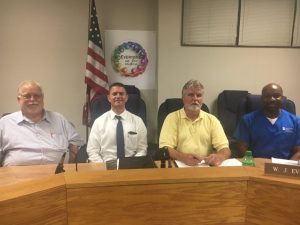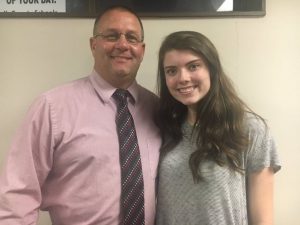News
Evins Returned as School Board Chairman (VIEW VIDEO OF PRINCIPALS REPORT HERE)
September 13, 2018
By: Dwayne Page (YOU MAY NOW SELECT LANGUAGES FOR READING ON THIS WEBSITE ON THE LEFT SIDE OF EACH PAGE BELOW THE SEARCH WINDOW)
Fifth district member W.J. (Dub) Evins, III has been re-elected Chairman of the Board of Education.
Evins was named by his fellow board members to serve another year as chairman during Thursday night’s regular monthly meeting.
“Thank you. I will do the best I can. We will have a year with quite a few things going on but we can make it a good year of opportunity with a building program and a number of other projects. I wish us all best of luck and blessings,” said Chairman Evins.
First district member Danny Parkerson was elected Vice-Chairman and Seventh District member Shaun Tubbs was re-elected Assistant Secretary.
M2U02818 from dwayne page on Vimeo.
The board re-organizes each September electing officers to serve for the year.
Chairman Evins welcomed the Board’s newest member, Alan Hayes who now serves the second district. Thursday night was Hayes’ first meeting as a member of the board.
The school board granted permission for the DCHS Tigerette Softball program to build a 40’ x 60’ covered batting cage beside the softball field on the home side. The batting cage will be covered by a roof but there will be no sides other than netting. It will be paid for by funds generated in the softball program.
Chairman Evins announced that 2018 employee health insurance premiums are rising by 2.5% but that the school system has available funds in the budget to absorb the increased cost without having to pass it on to the employees. The board voted to make it official.
The DeKalb County Youth Soccer Program was granted permission to use the grounds this year at Northside Elementary School for league play. The approval is conditional provided that the school system does not need the grounds for new school construction. The Soccer program can’t get insurance for the fall league until it receives a letter of approval from the board of education to use the Northside school grounds.
Director Patrick Cripps provided his monthly update on personnel moves.
Those employed are as follows:
Crystal Barnes, teacher to succeed Janet England
Toby Nokes, educational assistant at DCHS
Miranda Waggoner, educational assistant at DCHS
Tiffany Willmore, educational assistant at Smithville Elementary School
Leave of Absence as requested:
Suzanne Gash, Jennifer Herndon, Rachel Hernandez, and Heather Shehane
Transfers:
Tena Edwards to DCHS as educational assistant, Distance Learning Lab
Robbie Frazier to DeKalb West School replacing Holly Bain
Isabella Johnson from substitute to educational assistant replacing Stephanie Stewart
Resignations/Retirements
Holly Bain has resigned as pre-k educational assistant at DeKalb West School
Todd Davis has resigned as custodian at DeKalb West School
Janet England has retired as teacher at DeKalb West School
Danyelle Hawkins has resigned as DCHS teacher
Stephanie Stewart has resigned as educational assistant at DCHS
Norman Underhill has resigned as educational assistant at DCHS.
DCHS Principal Randy Jennings, DeKalb Middle School Principal Amanda Dakas, DeKalb West School Principal Sabrina Farler, and Assistant Principal of Northside Elementary School Beth Pafford updated the school board on activities at their schools.
Principal Jennings acknowledged the 2018-19 Mr. and Miss DCHS Tanner Poss and Madi Cantrell. He also recognized Madi Cantrell for being named a semi-finalist for the National Merit Scholarship Program. Jennings further mentioned that Anna Chew and Isaac Walker have both advanced to the Region Golf Tournament set for next week. DCHS Homecoming is the week of September 24-28.
Principal Dakas said the Chrome Book rollout at DeKalb Middle School has been successful. “I personally want to take this opportunity to thank the board and Mr. Cripps for ensuring that all of our students have this opportunity to have this electronic device in their hands. We’re able to do a lot more with it. We thank you for that. Also the grant that has given us Mr. Doug Eaton who is helping us provide technology support as we roll out this piece of technology. It is very much appreciated. He is extremely helpful to our teachers and to our students. We are grateful to him as well. Our PTO chili supper is tentatively set for November 10. We would like to invite everyone in the community out for that. We will also be updating our school web site as well with more information. We would also like to remind parents that attendance is crucial to student success and we thank the parents at DeKalb Middle School for working with us to ensure that their students are there,” said Dakas.
Principal Farler said DeKalb West, which implemented a student of the month recognition about a year ago, is now recognizing a teacher of the month. Ms Vicki Wilson is our teacher of the month for September. We are very excited to recognize her for dedication and hard work. We will make pictures at DeKalb West School next Tuesday, September 18 and our PTO Run for the Dogs event is scheduled for Thursday, September 27 from about 8:30 a.m. until lunch time. I also want to remind parents to sit down and read with their child at least 20 minutes a day,” said Farler.
Assistant Principal Pafford said Northside Elementary School will host the annual Fun Run Friday, September 14. “That is our big PTO fundraiser each year. This year they are adding an obstacle course for the kids to make it a little bit different. All families are invited to come out and share in that. Our fourth graders will run at 11 a.m. and the second and third grades will run at noon and the fifth grade will run at 1 p.m,” said Pafford.
DCHS Senior Madi Cantrell Named Semifinalist for National Merit Scholarship Program
September 13, 2018
By: Dwayne Page
A DeKalb County High School senior has qualified as a Semifinalist for the National Merit Scholarship Program.
Madison Elizabeth (Madi) Cantrell, daughter of Todd and Jenny Cantrell, has been named among 16,000 Semifinalists nationwide for this honor. The National Merit® Scholarship Program awards individual students who show exceptional academic ability and potential for success in rigorous college studies.
Cantrell has been identified among these academically talented high school seniors who have an opportunity to continue in the competition for some 7,500 National Merit Scholarships worth more than $31 million that will be offered next spring. To be considered for a Merit Scholarship® award, Semifinalists must fulfill several requirements to advance to the Finalist level of the competition. Over 90 percent of the Semifinalists are expected to attain Finalist standing, and about half of the Finalists will win a National Merit Scholarship, earning the Merit Scholar® title.
“We are very, very proud of Madison. This is my 17th year here at DCHS and this is only the second student we have had during that time to qualify as a semifinalist,” said Lori Myrick, Guidance Counselor at DCHS.
Principal Randy Jennings informed Director of Schools Patrick Cripps and the Board of Education of this honor for Madison during Thursday night’s regular monthly school board meeting. He also introduced Madison who was seated in the audience.
NMSC, a not-for-profit organization that operates without government assistance, was established in 1955 specifically to conduct the annual National Merit Scholarship Program. Scholarships are underwritten by NMSC with its own funds and by approximately 410 business organizations and higher education institutions that share NMSC’s goals of honoring the nation’s scholastic champions and encouraging the pursuit of academic excellence.
Over 1.6 million juniors in about 22,000 high schools entered the 2019 National Merit Scholarship Program by taking the 2017 Preliminary SAT/National Merit Scholarship Qualifying Test (PSAT/NMSQT®), which served as an initial screen of program entrants. The nationwide pool of Semifinalists, representing less than one percent of U.S. high school seniors, includes the highest scoring entrants in each state. To become a Finalist, the Semifinalist and his or her high school must submit a detailed scholarship application, in which they provide information about the Semifinalist’s academic record, participation in school and community activities, demonstrated leadership abilities, employment, and honors and awards received. A Semifinalist must have an outstanding academic record throughout high school, be endorsed and recommended by a high school official, write an essay, and earn SAT® scores that confirm the student’s earlier performance on the qualifying test. From the approximately 16,000 Semifinalists, about 15,000 are expected to advance to the Finalist level, and in February they will be notified of this designation. All National Merit Scholarship winners will be selected from this group of Finalists. Merit Scholar designees are selected on the basis of their skills, accomplishments, and potential for success in rigorous college studies, without regard to gender, race, ethnic origin, or religious preference.
DeKalb County’s Indiana Jones Explores South America
September 13, 2018
By: Bill Conger
DeKalb County has its own version of the famous Indiana Jones movie character. 19-year-old Bailey Redmon, a 2017 D.C.H.S. graduate, flew to Gurupa Miri, Brazil this summer for a history-marking archeology expedition.
Along with a team of M.T.S.U. students, the History major dug a 2 meter by 1 meter unit, looking for relics
“We got about 60 centimeters down where it was too deep to reach into, so we had to actually get into it,” Redmon recalls. “One of the girls that I was working with took off her shoes and got in. As soon as she got in, the corner of it collapsed.”
That turned out to be a fortuitous event that revealed an empty ant colony filled with ceramics and vases. It was basically a past generation’s dumping spot that archeologists call trash midden.
“We found shards that were decorated,” Redmon explained. “We think just by the style of the decoration that they were a prehistoric age. We found a couple of pieces of animal bone. Where we dug was an actual mound. There they look for mounds because there’s this soil formation called Terra preta, a type of very dark, fertile anthropogenic soil found in the Amazon Basin. It’s only made by the slash-and-burn agriculture that they do down in South America.”
“There would be like what we call a trash midden in archeology where they dump all their trash. Anything they wanted to discard they would burn it. That’s what we were finding. No human remains. If we found human remains, we more than likely had to have shut down the unit because the people in the community are very sensitive about that. They believe if we mess with any kind of human remains and take them away from where they were buried, then somebody in the community would get sick or they’ll die. It’s just bad luck.”
Getting permission to excavate in the area took years of relationship building in the community.
“We didn’t know if we were going to find anything, but the whole reason they chose to dig there was because archeology had never been performed there,” Redmon said. “Not that they didn’t care about their heritage, but it never really occurred to the people there could be more underneath the surface of where they lived. They were curious.”
“We were making history just by digging there, not necessarily what we were finding, because there never had really been any excavations there but in the past couple of years. I didn’t know that until we got there. We thought it had been a working site for years. “No, it’s only been two years.” So, it was like chill bumps. This is crazy,” she said, laughing.
The Archeology and Medieval Studies minor spent a month in the Portuguese-speaking nation.
“The people treated us like family even though they couldn’t communicate with us. There was this one family. The woman’s name was Doña Arlete We would go down to her house every night after we got done excavating. She would feed us all these sorts of fruits and foods that we hadn’t tried before. She treated us like we were her daughters.”
“She lived right on the Amazon River, so we would swim in the Amazon. The current was really strong, but it was muddy. You couldn’t see. It was a narrow channel so there was a lot of vegetation, jungle vines and trees. There would be huge water lilies that would float down. You would have to dodge them as you were swimming. It was cool.
“I was afraid of the piranhas because that’s where they live, but the Brazillians were jumping in. [I thought] you’re fine. I just jumped in and took a risk. That’s something that I’m glad I did and didn’t hold back and not do it because that’s something I’ll remember for the rest of my life.”
During her two-and-a-half week adventure, she slept in a hammock in a non-air conditioned hut. Although it’s the winter season there in July, cooler than normal temperatures hovered around 85 degrees couple with 100% humidity. As she tried to snooze at night, she met a special friend hanging overhead.
“There was a tarantula that lived there. He was probably about baseball size or so not including his legs. He would come out during the night rain, and he would catch his bugs and not move a muscle. I had a bug net, so I thought worse scenario, he could just fall on me during the night, and I would have to bounce him off of my net.
I ended up having fun with it. I named him Caleb because I thought if I gave him a name, then he wouldn’t seem so intimidating to me. So, every time he would come out, I’d be like, “Hey, Caleb! He’s back’.”
Redmon also got up-close and personal with several other creepy creatures.
“We also had bats that lived with us in the hut. We had huge long centipedes that were around the floor. We had frogs in the shower. All the wildlife you could imagine we had it. Fire ants were terrible.. Underneath some of the boards [on the way to the river], there’d be a colony of ants. So, I got bit several times. I started wearing my work boots with my bathing suit down to the river. I don’t care if I look silly. I’m not getting bit.”
“We had snakes that would fall into our unit [excavation site] at night, and we would have to come and kill them. Usually, they were venomous. There were also hunter spiders that would make their little nests beside our unit. They’re the ones that burrow into the ground and when an insect walks by, they jump out and grab it and bring it back into their hole. We’d have to take a machete and shove it down the hole and tear up the hole to get the spider to come out. Then, either kill it or let it run away.”
Redmon, an M.T.S.U. Senior, hopes to earn her Master’s and PhD at York University in England after she graduates next May. One day she wants to work in historical archeology. Redmon says the obstacles she faced during her trip changed her life.
“I was not prepared for that the first couple of days, but you get used to it. Oh, it’s just a snake or oh, it’s just a tarantula. I’m not skittish around that kind of stuff anymore because of that trip. It just made me grow so much as a person other than that.
“These people … encounter the same things that we did, and they still are some of the happiest people I’ve ever met in my life. They don’t let it get to them. I try to mimic that mentality. There’s nothing you can control, so you might as well be positive about it. If that trip taught me anything, it was a positive outlook is the best thing to have, especially in a tough situation like that.”
« First ‹ Previous 1 2119 2209 2217 2218 22192220 2221 2229 2319 2493 Next › Last »














